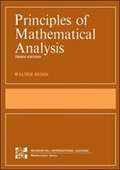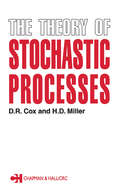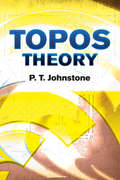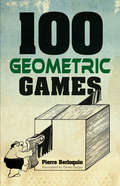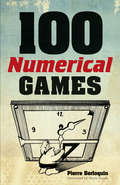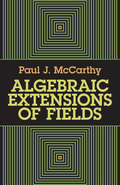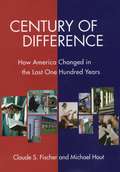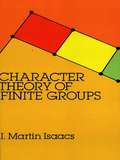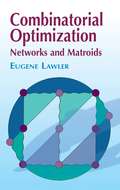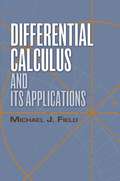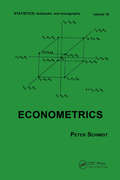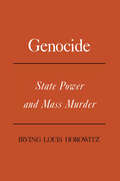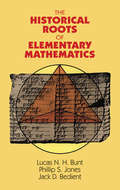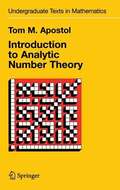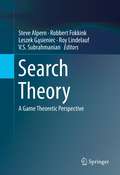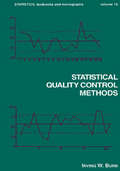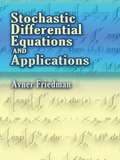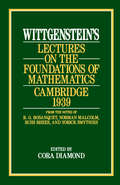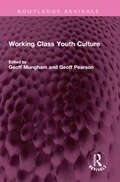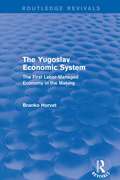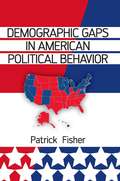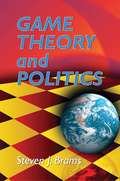- Table View
- List View
Principles Of Mathematical Analysis (International Series In Pure And Applied Mathematics)
by Walter RudinThe third edition of this well known text continues to provide a solid foundation in mathematical analysis for undergraduate and first-year graduate students. The text begins with a discussion of the real number system as a complete ordered field. (Dedekind's construction is now treated in an appendix to Chapter I.) The topological background needed for the development of convergence, continuity, differentiation and integration is provided in Chapter 2. There is a new section on the gamma function, and many new and interesting exercises are included. This text is part of the Walter Rudin Student Series in Advanced Mathematics.
The Theory of Stochastic Processes
by D.R. CoxThis book should be of interest to undergraduate and postgraduate students of probability theory.
Topos Theory (Dover Books on Mathematics)
by P. T. JohnstoneOne of the best books on a relatively new branch of mathematics, this volume focuses on how topos theory integrates geometric and logical ideas into the foundations of mathematics and theoretical computer science. Topics include internal category theory, topologies and sheaves, geometric morphisms, natural number objects, cohomology, set theory, and more. 1977 edition.
100 Geometric Games
by Martin Gardner Pierre Berloquin Denis DugasThere are three loops in a tangle of rope. How many are independent, and how many are interlocked?Two knights stand on a chessboard. How many other knights must you add so that each square is occupied or threatened by a knight?Among six seemingly identical drawings of mandalas, each rotated by multiples of 60 degrees, one is different. Which is it, and why?Challenge yourself with these mind-benders, brainteasers, and puzzles. Each of them has been carefully selected so that none will be too tough for anyone without a math background - but they're not too easy. Some are original, and all are clearly and accurately answered at the back of the book.
100 Numerical Games
by Martin Gardner Pierre Berloquin Denis DugasFollow the hour hand and minute hand of a clock for 24 hours. How many times do they form a right angle?Timothy's house has several rooms, each of which has an even number of doors, including doors that lead outside. Is the number of outside doors even or odd?Stimulating and delightful, this collection of puzzles features original and classic brainteasers. The author, a puzzle columnist for Le Monde, specially selected these mind-benders for the widest possible audience, ensuring that they're neither too hard for those without a math background nor too easy for the mathematically adept. All puzzles are clearly stated and accurately answered at the back of the book - and they're great fun to consider, whether you crack them or not. Includes a Foreword by Martin Gardner.
Algebraic Extensions of Fields
by Paul J. Mccarthy"...clear, unsophisticated and direct..." -- MathThis textbook is intended to prepare graduate students for the further study of fields, especially algebraic number theory and class field theory. It presumes some familiarity with topology and a solid background in abstract algebra. Chapter 1 contains the basic results concerning algebraic extensions. In addition to separable and inseparable extensions and normal extensions, there are sections on finite fields, algebraically closed fields, primitive elements, and norms and traces. Chapter 2 is devoted to Galois theory. Besides the fundamental theorum of Galois theory and some examples, it contains discussions of cyclic extensions, Abelian extensions (Kummer theory), and the solutions of polynomial equations by radicals. Chapter 2 concludes with three sections devoted to the study of infinite algebraic extensions. The study of valuation theory, including a thorough discussion of prolongations of valuations, begins with Chapter 3. Chapter 4 is concerned with extensions of valuated field, and in particular, with extensions of complete valuated fields. Chapter 5 contains a proof of the unique factorization theorum for ideals of the ring of integers of an algebraic number field. The treatment is valuation-theoretic throughout. The chapter also contains a discussion of extensions of such fields. A special feature of this book is its more than 200 exercises - many of which contain new ideas and powerful applications - enabling students to see theoretical results studied in the text amplified by integration with these concrete exercises.
Century of Difference: How America Changed in the Last One Hundred Years
by Claude S. Fischer Michael HoutIn every generation, Americans have worried about the solidarity of the nation. Since the days of the Mayflower, those already settled here have wondered how newcomers with different cultures, values, and (frequently) skin color would influence America. Would the new groups create polarization and disharmony? Thus far, the United States has a remarkable track record of incorporating new people into American society, but acceptance and assimilation have never meant equality. In Century of Difference, Claude Fischer and Michael Hout provide a compelling—and often surprising—new take on the divisions and commonalities among the American public over the tumultuous course of the twentieth century. Using a hundred years worth of census and opinion poll data, Century of Difference shows how the social, cultural, and economic fault lines in American life shifted in the last century. It demonstrates how distinctions that once loomed large later dissipated, only to be replaced by new ones. Fischer and Hout find that differences among groups by education, age, and income expanded, while those by gender, region, national origin, and, even in some ways, race narrowed. As the twentieth century opened, a person’s national origin was of paramount importance, with hostilities running high against Africans, Chinese, and southern and eastern Europeans. Today, diverse ancestries are celebrated with parades. More important than ancestry for today’s Americans is their level of schooling. Americans with advanced degrees are increasingly putting distance between themselves and the rest of society—in both a literal and a figurative sense. Differences in educational attainment are tied to expanding inequalities in earnings, job quality, and neighborhoods. Still, there is much that ties all Americans together. Century of Difference knocks down myths about a growing culture war. Using seventy years of survey data, Fischer and Hout show that Americans did not become more fragmented over values in the late-twentieth century, but rather were united over shared ideals of self-reliance, family, and even religion. As public debate has flared up over such matters as immigration restrictions, the role of government in redistributing resources to the poor, and the role of religion in public life, it is important to take stock of the divisions and linkages that have typified the U.S. population over time. Century of Difference lucidly profiles the evolution of American social and cultural differences over the last century, examining the shifting importance of education, marital status, race, ancestry, gender, and other factors on the lives of Americans past and present. A Volume in the Russell Sage Foundation Census Series
Character Theory of Finite Groups
by I. Martin Isaacs"The book is a pleasure to read. There is no question but that it will become, and deserves to be, a widely used textbook and reference." -- Bulletin of the American Mathematical Society.Character theory provides a powerful tool for proving theorems about finite groups. In addition to dealing with techniques for applying characters to "pure" group theory, a large part of this book is devoted to the properties of the characters themselves and how these properties reflect and are reflected in the structure of the group.Chapter I consists of ring theoretic preliminaries. Chapters 2 to 6 and 8 contain the basic material of character theory, while Chapter 7 treats an important technique for the application of characters to group theory. Chapter 9 considers irreducible representations over arbitrary fields, leading to a focus on subfields of the complex numbers in Chapter 10. In Chapter 15 the author introduces Brauer's theory of blocks and "modular characters." Remaining chapters deal with more specialized topics, such as the connections between the set of degrees of the irreducible characters and structure of a group. Following each chapter is a selection of carefully thought out problems, including exercises, examples, further results and extensions and variations of theorems in the text.Prerequisites for this book are some basic finite group theory: the Sylow theorems, elementary properties of permutation groups and solvable and nilpotent groups. Also useful would be some familiarity with rings and Galois theory. In short, the contents of a first-year graduate algebra course should be sufficient preparation.
Combinatorial Optimization: Networks and Matroids (Dover Books on Mathematics)
by Eugene LawlerPerceptively written text examines optimization problems that can be formulated in terms of networks and algebraic structures called matroids. Chapters cover shortest paths, network flows, bipartite matching, nonbipartite matching, matroids and the greedy algorithm, matroid intersections, and the matroid parity problems. A suitable text or reference for courses in combinatorial computing and concrete computational complexity in departments of computer science and mathematics.
Differential Calculus and Its Applications (Dover Books on Mathematics)
by Prof. Michael J. FieldThis text offers a synthesis of theory and application related to modern techniques of differentiation. Based on undergraduate courses in advanced calculus, the treatment covers a wide range of topics, from soft functional analysis and finite-dimensional linear algebra to differential equations on submanifolds of Euclidean space. Suitable for advanced undergraduate courses in pure and applied mathematics, it forms the basis for graduate-level courses in advanced calculus and differential manifolds. Starting with a brief resume of prerequisites, including elementary linear algebra and point set topology, the self-contained approach examines liner algebra and normed vector spaces, differentiation and calculus on vector spaces, and the inverse- and implicit-function theorems. A final chapter is dedicated to a consolidation of the theory as stated in previous chapters, in addition to an introduction to differential manifolds and differential equations.
Econometrics: Microeconomics
by Peter Schmidt"A collection of proofs of fundamental theorems, this volume utilizes a format that is exhaustive and consistent. Every result covered in ``Econometrics''is proved as well as stated. One notation system is used throughout the volume. The topics included in the book cover such areas as estimations and testing in linear regression models under various sets of assumptions, and estimation and testing in simultaneous equations models. The latter subject is treated more extensively than in most econometrics books, and the entire volume is characterized by its rigorous level of examination. "
Genocide: State Power and Mass Murder (Issues In Contemporary Civilization Ser.)
by James BaldwinThis book is dedicated to a consideration of genocide in the context of political sociology. It demonstrates that the underlining predicates of sociology give scant consideration to basic issues of life and death in favor of distinctly derivative issues of social structure and social function.
The Historical Roots of Elementary Mathematics
by Lucas N. Bunt Jack D. Bedient Phillip S. Jones"Will delight a broad spectrum of readers." -- American Mathematical MonthlyDo long division as the ancient Egyptians did! Solve quadratic equations like the Babylonians! Study geometry just as students did in Euclid's day! This unique text offers students of mathematics an exciting and enjoyable approach to geometry and number systems. Written in a fresh and thoroughly diverting style, the text -- while designed chiefly for classroom use -- will appeal to anyone curious about mathematical inscriptions on Egyptian papyri, Babylonian cuneiform tablets, and other ancient records.The authors have produced an illuminated volume that traces the history of mathematics -- beginning with the Egyptians and ending with abstract foundations laid at the end of the 19th century. By focusing on the actual operations and processes outlined in the text, students become involved in the same problems and situations that once confronted the ancient pioneers of mathematics. The text encourages readers to carry out fundamental algebraic and geometric operations used by the Egyptians and Babylonians, to examine the roots of Greek mathematics and philosophy, and to tackle still-famous problems such as squaring the circle and various trisectorizations.Unique in its detailed discussion of these topics, this book is sure to be welcomed by a broad range of interested readers. The subject matter is suitable for prospective elementary and secondary school teachers, as enrichment material for high school students, and for enlightening the general reader. No specialized or advanced background beyond high school mathematics is required.
Introduction to Analytic Number Theory (Undergraduate Texts in Mathematics)
by Tom ApostolThis book is the first volume of a two-volume textbook for undergraduates and is indeed the crystallization of a course offered by the author at the California Institute of Technology to undergraduates without any previous knowledge of number theory.
Proofs and Refutations
by John Worrall Elie ZaharProofs and Refutations is essential reading for all those interested in the methodology, the philosophy and the history of mathematics. Much of the book takes the form of a discussion between a teacher and his students. They propose various solutions to some mathematical problems and investigate the strengths and weaknesses of these solutions. Their discussion (which mirrors certain real developments in the history of mathematics) raises some philosophical problems and some problems about the nature of mathematical discovery or creativity. Imre Lakatos is concerned throughout to combat the classical picture of mathematical development as a steady accumulation of established truths. He shows that mathematics grows instead through a richer, more dramatic process of the successive improvement of creative hypotheses by attempts to 'prove' them and by criticism of these attempts: the logic of proofs and refutations.
Search Theory
by Leszek Gąsieniec V. S. Subrahmanian Steve Alpern Roy Lindelauf Robbert FokkinkSearch games and rendezvous problems have received growing attention in computer science within the past few years. Rendezvous problems emerge naturally, for instance, to optimize performance and convergence of mobile robots. This gives a new algorithmic point of view to the theory. Furthermore, modern topics such as the spreading of gossip or disease in social networks have lead to new challenging problems in search and rendezvous. Search Theory: A Game Theoretic Perspective introduces the first integrated approach to Search and Rendezvous from the perspectives of biologists, computer scientists and mathematicians. This contributed volume covers a wide range of topics including rendezvous problems and solutions, rendezvous on graphs, search games on biology, mobility in governed social networks, search and security, and more. Most chapters also include case studies or a survey, in addition to a chapter on the future direction of Search and Rendezvous research. This book targets researchers and practitioners working in computer science, mathematics and biology as a reference book. Advanced level students focused on these fields will also find this book valuable as a secondary text book or reference.
Statistical Quality Control Methods: Statistics: A Series of Textbooks and Monographs
by Irving W. BurrStatistical Quality Control Methods by Irving W. Burr.
Stochastic Differential Equations and Applications (Dover Books on Mathematics)
by Prof. Avner FriedmanThis text develops the theory of systems of stochastic differential equations, and it presents applications in probability, partial differential equations, and stochastic control problems. Originally published in two volumes, it combines a book of basic theory and selected topics with a book of applications.The first part explores Markov processes and Brownian motion; the stochastic integral and stochastic differential equations; elliptic and parabolic partial differential equations and their relations to stochastic differential equations; the Cameron-Martin-Girsanov theorem; and asymptotic estimates for solutions. The section concludes with a look at recurrent and transient solutions.Volume 2 begins with an overview of auxiliary results in partial differential equations, followed by chapters on nonattainability, stability and spiraling of solutions; the Dirichlet problem for degenerate elliptic equations; small random perturbations of dynamical systems; and fundamental solutions of degenerate parabolic equations. Final chapters examine stopping time problems and stochastic games and stochastic differential games. Problems appear at the end of each chapter, and a familiarity with elementary probability is the sole prerequisite.
The Triangle (Surprising Shapes)
by Patricia Smeltzer Victor SmeltzerA series of "fun" books to give young children a basic idea of shapes, sizes and colours.
Wittgenstein's Lectures on the Foundations of Mathematics, Cambridge 1939
by Cora DiamondFor several terms at Cambridge in 1939, Ludwig Wittgenstein lectured on the philosophical foundations of mathematics. A lecture class taught by Wittgenstein, however, hardly resembled a lecture. He sat on a chair in the middle of the room, with some of the class sitting in chairs, some on the floor. He never used notes. He paused frequently, sometimes for several minutes, while he puzzled out a problem. He often asked his listeners questions and reacted to their replies. Many meetings were largely conversation. These lectures were attended by, among others, D. A. T. Gasking, J. N. Findlay, Stephen Toulmin, Alan Turing, G. H. von Wright, R. G. Bosanquet, Norman Malcolm, Rush Rhees, and Yorick Smythies. Notes taken by these last four are the basis for the thirty-one lectures in this book. The lectures covered such topics as the nature of mathematics, the distinctions between mathematical and everyday languages, the truth of mathematical propositions, consistency and contradiction in formal systems, the logicism of Frege and Russell, Platonism, identity, negation, and necessary truth. The mathematical examples used are nearly always elementary.
Working Class Youth Culture (Routledge Revivals)
by Geoff Mungham Geoff PearsonFirst published in 1976, Working Class Youth Culture offers a much-needed alternative viewpoint to the law-and-order lobby which treats the youth question as a dreadful pest to be exterminated or caged in. The contributors describe the real conditions of life for working-class youth; how they make sense of the world; and how we can understand their perspective. The subjects discussed include Teddy Boys, Mods, Skinheads and the Glamrock Cult; dance-hall fights; picking up girls and going steady; how schools manufacture delinquency, truancy and vandalism; how working-class kids slide from bad schools to bad jobs, or to no jobs at all; Paki-bashing, racism and the competition over jobs and houses; how social change in post-war Britain has influenced youth culture; and how social scientists have hidden the real character of youth troubles behind the myth of a classless society. This book will be of interest to students of sociology and anthropology.
The Yugoslav Economic System (Routledge Revivals): The First Labor-Managed Economy in the Making
by Branko HorvatFirst published in 1976, this book traces the development of the Yugoslav economy from the end of the Second World War to the beginning of 1975, which the author argues was a highly productive era of social innovation. Drawing on personal experience of the Revolution, the Partisan Liberation War and his time as a member of the Federal Planning Board as well as a comprehensive array of written sources, the author attempts to understand the development process, compare policy proclamations with achieved results, study the theories and ideas that led a to certain policy, distinguish the economic and political ingredients in decision making and analyses the causes of success and failure.
Data Analysis for Scientists and Engineers
by Stuart L. MeyerWiley series in probability and mathematical statistics
Demographic Gaps in American Political Behavior
by Patrick FisherDemographic Gaps in American Political Behavior examines the political behavior of various groups in the United States in an effort to demonstrate how demographic backgrounds and socialization affect political behavior. Media coverage has disproportionately focused on the red state versus blue state divide, leaving the impression that American political behavior is determined solely by place of residence. This, however, ignores the numerous other political divides that exist in the United States today. In order to better conceptualize the landscape of American political behavior, Patrick Fisher analyzes the political gaps in six different demographics--income, religion, gender, race, age, and geography--and examines the effect these political gaps have on public opinion, policy, and party positioning. Written in an accessible fashion, Demographic Gaps in American Political Behavior uses contemporary examples and data from the 2008 and 2012 elections to help readers understand how and why demographic background has the potential to greatly influence political opinions and behavior.
Game Theory and Politics
by Steven J. BramsIn this illuminating and instructive survey, author Steven J. Brams demonstrates both the insights and the pitfalls that can result from applying game theoretic models to the analysis of problems in political science. Using plenty of real-life examples, Brams shows how game theory can explain and elucidate complex political situations, from warfare to presidential vetoes. In these cases and others, game theory's mathematical structure provides a rigorous, consistent method for formulating, analyzing, and solving strategic problems. Minimal mathematical background is necessary, making the book accessible to a wide audience of students and teachers of politics and social science, as well as other readers with a serious interest in politics. New preface to the Dover edition. 1975 edition.
